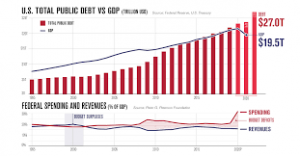America’s National Debt Evolved Over Different Presidencies
America’s national debt has become a huge issue for Americans, with many worrying that it’s getting out of hand. This is because the federal government spends more each year than it takes in, leading to budget deficits that contribute to national debt levels. In recent years, deficits have tended to be bigger than expected. A recent Pew research study found that 57% of Americans believe reducing the national debt should be a top priority for Congress and the President.
However, the precise causes of this increase are complex and controversial. Some have argued that the debt has risen because of policies championed by the Republican Party, while others have claimed that higher interest rates and faster than-expected increases in entitlement spending are to blame. The truth is probably a mixture of both, with the national debt currently standing at $16 trillion and rising rapidly.

The America national debt is the sum of money that the United States owes to its creditors, who are comprised of individual investors, businesses, commercial banks, mutual funds, state and local governments, and foreign governments. This money is owed for various reasons, including funding wars, paying for disaster relief, and providing retirement benefits to citizens.
How Has America’s National Debt Evolved Over Different Presidencies?
When looking at a country’s national debt, it’s helpful to compare it to its gross domestic product (GDP), which is the measure of all of the country’s economic activity. A high debt-to-GDP ratio can signal that a nation is not able to repay its debts and may be more likely to face economic problems in the future.
A nation’s debt-to-GDP ratio can be influenced by a number of factors, including policy changes, the strength of its economy, and the rate at which it is growing. The debt-to-GDP ratio for the United States has been volatile, increasing and decreasing at various times throughout its history, depending on the circumstances of each period.
One way to see how a President has affected the nation’s debt levels is to look at the percentage of GDP that the national debt represents during his or her presidency. Some Presidents, like Ronald Reagan and George W. Bush, have increased the national debt significantly, while others have reduced it. During the 1990s, a combination of defense cuts, tax increases, and an economic boom led to a reduction in the national debt as a percentage of GDP.
The President who added the most to the national debt in terms of percentage was Franklin D. Roosevelt, whose New Deal programs contributed to the Great Depression and the second World War, both of which increased debt levels considerably. However, the biggest single contribution to the national debt in terms of dollars was made by Abraham Lincoln, who added $236 billion to the national debt while in office. This was mainly because of the costs associated with funding the American Civil War, which was one of the largest military campaigns in history at the time. This increase was the fifth largest in dollar terms in U.S. history.

